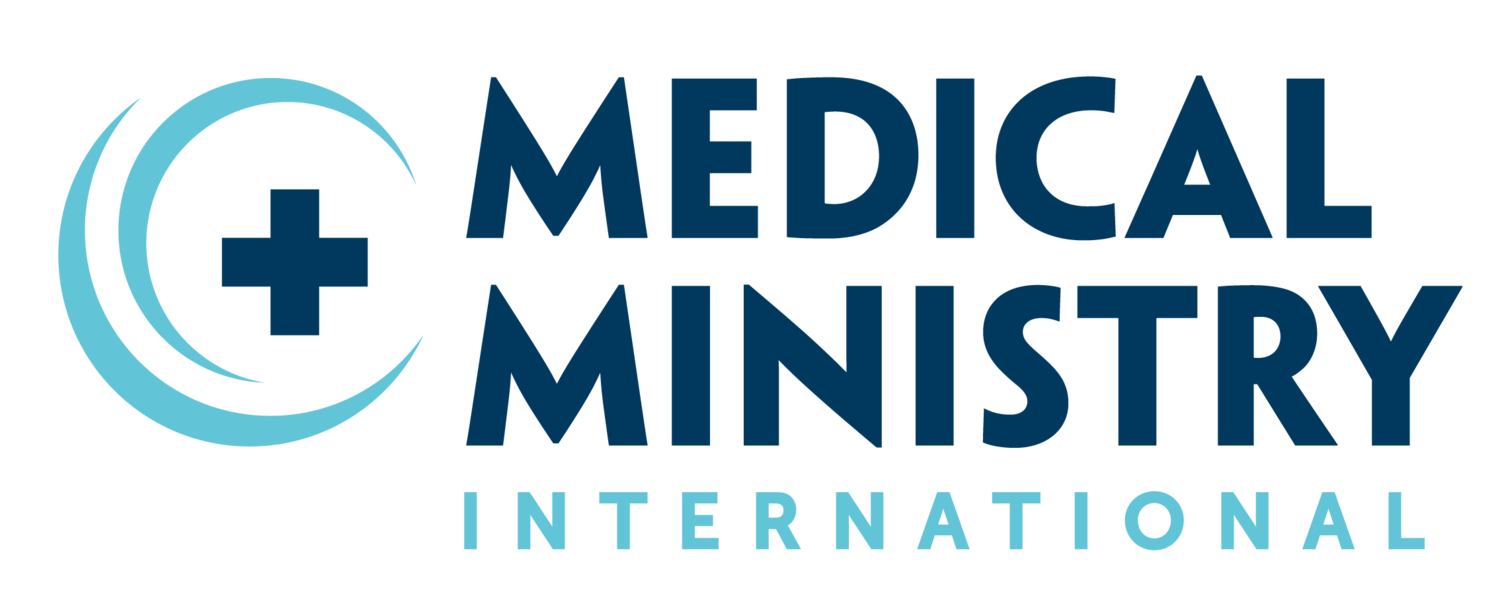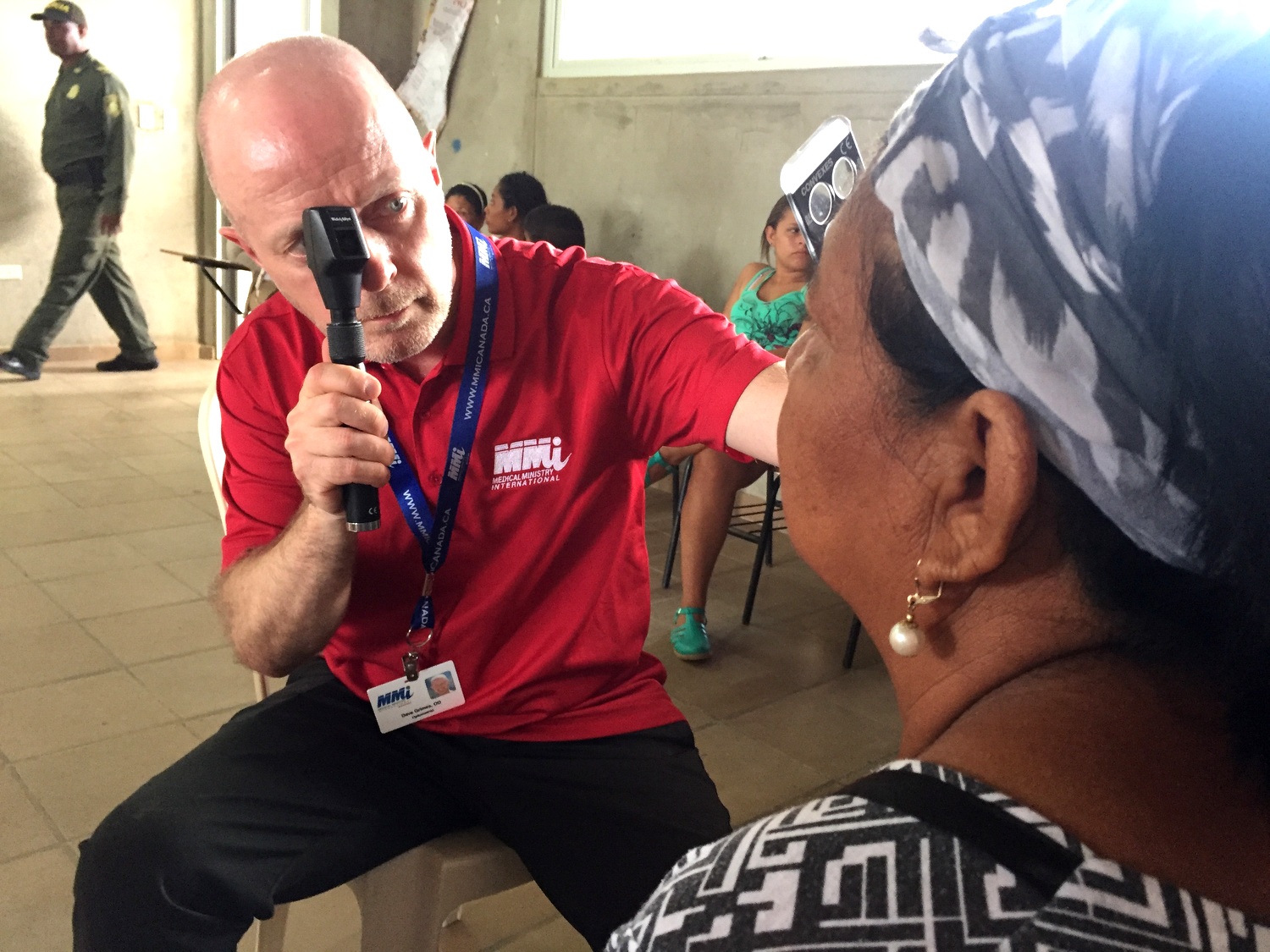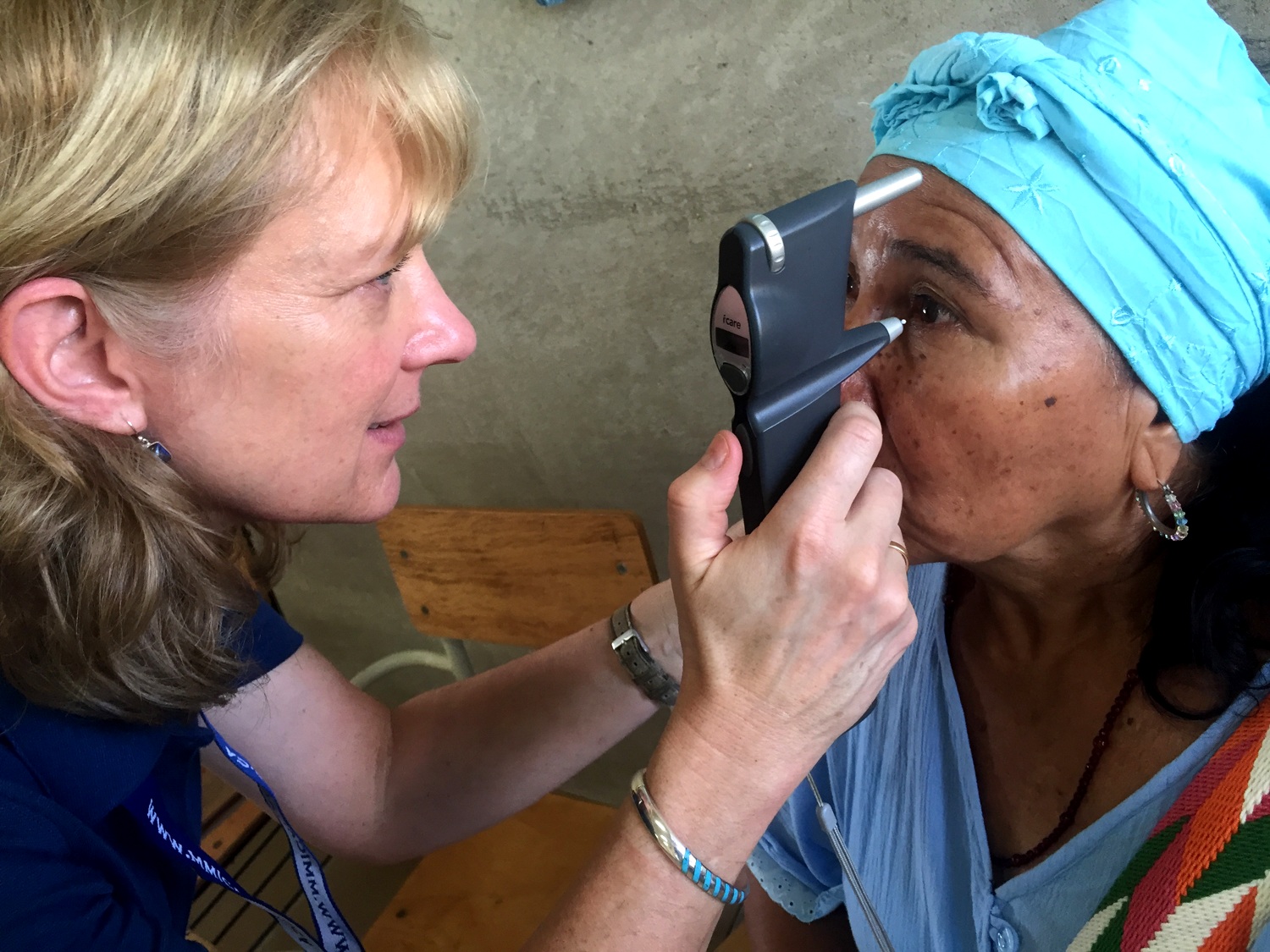Medical Ministry International in Colombia
Medical Ministry International first travelled to Colombia in 2004, under the leadership of Willie and Janice Hunter and at the invitation of Antonio and Ruth Cortes and the Iglesia Cruzada. Project teams in Colombia aim to provide basic primary care and dental care in the Amazon Region, as well as specialized vision services. Vision care projects are focused in urban areas, and include opportunities for local medical personnel to receive training. These large projects typically see a high volume of patients seeking a wide range medical services. Through Medical Ministry International and our project partners, the 'blind' can now see.
Juan Alan Muñoz was born in 1972 to a Colombian father and an Irish mother, who were called to be missionaries in the Amazon jungle of Colombia. Juan Alan studied Economics at university in Northern Ireland and Finance in Bogotá, Colombia. He has been working in the area of business administration in the health sector of Colombia since 1996. He began serving with Medical Ministry International as National Director of MMI Colombia in 2004 and as CEO of Clínica Leticia in 2013. He is a father of three children: Juan David, Andres Felipe, and Isabella, who also help Medical Ministry International. Juan Alan spends his time between Bogotá and Leticia, always with a cup of coffee in hand. Juan Alan and his wife, Leonor work closely with Medical Ministry International in planning the projects in the Amazon Region and other areas of Colombia.
Juan Alan Muñoz - Project Director
Juan Alan Muñoz is developing MMI Colombia with strong community leaders. Eye care projects led by Richard and Barbara Skinner and Juan Alan Muñoz have served over 65,000 patients since 2005 in Buenaventura, Barranquilla, Cartagena, Leticia, Ciénaga, and Riohacha.
Project Sites:
-
Barrancas is a town and municipality of the Colombian Department of La Guajira. The municipality of Barrancas is located to the left margin of the Ranchería River in a valley formed between the Sierra Nevada de Santa Marta mountains and the Serranía del Perijá.
Barrancas commercializes in small scale agricultural products such as coffee, plantain, cotton, maize and yuca, but the main economic activity in the municipality is the exploitation of coal at Cerrejón coal mine. The Cerrejón coal mine is one of the largest open pit coal mine in the world.
Elevation
40 m (131 ft)
Climate
The climate present in the region is predominantly hot and dry with no mountainous climate variations, maintaining an average temperature throughout the year of 28°C. -
Bocachica is located in the Cartagena Province of Colombia. The Province of Cartagena occupies much of the Caribbean coast of Colombia. The territory of the province was amorphous in shape, with borders that followed an undulating line edged by the foothills of the Andes mountains to the south, consisting of the Abibe, San Lucas, Ayapel and San Jerónimo mountains, running west along the Serrania del Darien and east along the Magdalena River.
Elevation
2 m (7 ft)
Climate
Tropical wet and dry climate. -
Ciénaga de Oro is located in the Córdoba Department in northern Colombia. Córdoba faces to the north with the Caribbean Sea. The region is known for their distinct cultural heritages, which include a blend of indigenous Zenú Indians, African descendants, colonial Spanish descendants, and more recently, Arab immigrants. Near the Sinú valley, the town is surrounded by tropical flora and fauna.
Project Description
Ciénaga de Oro is a new location for Medical Ministry International's work in 2019. The team will be seeing several Indigenous communities surrounding Ciénaga de Oro. The purpose of the project is to bring visual health to the people of the region of Ciénaga de Oro. The clinic will be set up in a school, and here the patients will also have access to the Integrated Health area after registration to hear about eye care, hygiene, preventing the spread of germs, dental health, and information about the clinic stations. Surgeries will take place at a local hospital.
Elevation
13 m (43 ft)
Climate
The region has a tropical wet and dry climate. May to November tend to be rainy, while December to April tend to be dry. Year-round, the average high temperature is 31°C (89°F) and the average low is 25°C (77°F). -
Riohacha, which translates into English as "River of the Axe" or "Axeshore", is a city in the Riohacha Municipality in the northern Caribbean Region of Colombia. It is located by the mouth of the Ranchería River and the Caribbean sea, capital city of the La Guajira Department. Founded by conquistador Nikolaus Federmann in 1535, Riohacha was named after a local legend "The legend of the Axe". Owing to the powerful rain shadow of the Sierra Nevada de Santa Marta, the area is mostly desertic. During colonial times, Riohacha was a very important port due to the discovery of vast numbers of pearls. In the second half of the 20th Century, the city became one of Colombia's maritime commercial ports.
Project Description
On these projects, surgeries take place at a local hospital in Riohacha, and the optical clinics are set up at a local school. The Integrated Health component of the projects is for patients to learn about eye care, hygiene, preventing the spread of germs, dental health, and information about the clinic stations. These projects are a comprehensive vision care team of Ophthalmologists, Optometrists, Opticians, Nurses, Technicians, and Support Team Members.
Elevation
5 m (16 ft)
Climate
On average, the temperatures are always high. There is little rainfall.
Patient Story
© Elizabeth Opalenik
"Why are you so happy?" "Because my mom can see again!" -Luz
Three years ago, Luz's mother, Dayli, was diagnosed with cataracts. The disease progressed rapidly and soon Dayli had no vision in her right eye, and only 20% in her left. Her daughters had to help her to do every-day tasks, like cooking and crossing the street.
When an MMI team visited her community in La Guajira, Colombia, a few weeks ago, Dayli was able to have surgery on her cataracts. After three years of struggling to see, Dayli's sight has been restored! “The first thing I saw was the face of the doctor, I felt great happiness” Dayli says, “I could not stop crying… [I feel that] God loves me. Despite all my sins - he still loves me.”
Travelling on a Project
-
Travelers are required to have a valid passport for the duration of their stay. Travel visa is not required.
• Americans: For more information see the US State Department website:
https://travel.state.gov/content/passports/en/country/colombia.html
• Canadians: Travelers to Putumayo, Meta, Gorgona (Cauca), Tayrona National Park (Magdalena), and Caquetá must produce proof of yellow fever vaccination, as it will be required by airlines for flights to these departments.
Please check the following website for the most current entry/exit requirements:
https://https://travel.gc.ca/destinations/colombia
• International: Please contact MMI office or Globespan for visa requirement if needed. -
Please email ALL CREDENTIALS upon application, as these must go to the Project Director in the country to be translated and then taken to the Ministry of Health to get temporary licenses prior to your arrival.
• For everyone, we need:
- Colour Scan / Photocopy of Passport (photo page)
- Colour photo for your name badge (any good photo, we can adjust size)
- Travel Itinerary
- Supply Lists
• Medical Professionals, we also need your:
- Current License (through time of project)
- Diploma (Techs, Nursing, Dental, MD and Board Certifications)
- Curriculum Vitae or Resume (this also will help the Project Director know your skills & experience to assign you a task on the project, especially for 1st time participants)
• Health Care Students: Letter of Good Standing from your school (including year of study and graduation date).
• All MINORS travelling with only one parent, or without their parents, will need a letter from BOTH parents stating that it is OK for the child to travel with one parent or an appointed guardian. The letter should be signed and notarized. MMI needs a copy of this letter, and the parent or guardian should carry the original letter while travelling. -
Airfare is not included on the Project Schedule because the costs for airfare vary significantly based on the country location, location of team members, and time of year.
Once accepted for a Project Team, participants can contact our designated travel agent to coordinate schedules with the team itinerary.
Globespan Travel Management www.globespan.com
Email: Globespan on behalf of Medical Ministry International mmitravel@globespan.com
Phone: Connie Kelsey at: (800) 810-1948 or (416) 322-7629
• Applicants from outside USA or Canada:
Travel arrangement can be procured locally or with the recommended agency, but arrivals & departures must coordinate with team.
• Airport: Riohacha, Colombia (Almirante Padilla Airport - RCH) via El Dorado International Airport Bogotá (BOG) on one continuous ticket. -
We strongly recommend that you consult a travel clinic, as they are aware of outbreaks and can suggest preventative immunizations. All routine immunizations should be up-to-date. Please check the following website for the most current information.
Americans: https://wwwnc.cdc.gov/travel/destinations/traveler/none/colombia
Canadians: https://travel.gc.ca/destinations/colombia -
MMI will arrange local accommodations for the team.
• Laundry Service: usually available for additional fee
• AC: dependent on location
• Phone Service: check with your cell phone provider, roaming is very expensive.
• Wifi/Internet: dependent on location
• Voltage: 110V.
• Meals: MMI will provide meals for the team. Dietary restrictions can be indicated on your application and we will do our best to accommodate your needs. Be sure to bring your own re-usable water bottle with a wide mouth for refilling. Purified water is supplied. If you would like to bring snacks to have throughout the day, please bring items such as peanut butter, granola bars, trail mix or pretzels and crackers in sealable containers (like Ziploc bags). -
• Language: Spanish (official)
• Religion:
- Roman Catholic: 90%
- Other: 10%
• Government: Presidential Republic -
The money in Colombia is called the Colombian Peso (COP). MMI staff will help you exchange money. All major credit cards are accepted in Colombia. Visa and MasterCard are the most commonly accepted. You must bring US dollars in good condition - torn, stamped or old bills will not be exchanged. Also, $1 bills are not useful in Colombia; they are exchanged for less than other bills. $100.00 bills that are older than 2006 or start with the series CB are not accepted.
MMI Amazon & Clinica Leticia
Medical Ministry International has formed an alliance with this clinic in Leticia. Here, a moderate level of health care are provided, such as surgeries and deliveries. In the Amazon region, many patients are transported weekly to Colombia’s capital, Bogotá, due to lack of advanced medical machines and specialists. Clinica Leticia is working to upgrade its facilities to reduce the number of air transports.
In some villages, there are individuals with very basic medical training, but resources and medicine are often extremely limited. Because of this, the villagers commonly wait until they are extremely sick before getting medical attention. Another factor that affects the villagers is distance; health centres are often far from their village and transportation can be unaffordable.
About Colombia
Country Background
Colombia is one of the most ethnically, linguistically, and ecologically biodiverse countries in the world. The urban centres are mostly located in the highlands of the Andes mountains, and the Colombian territory also encompasses Amazon rainforest, tropical grassland and both Caribbean and Pacific coastlines. Indigenous populations such as the Muisca, Quimbaya, and Tairona have mixed with Spanish, African, and Middle Eastern immigrants to create a culture as unique as its landscape. Colombia is the third most populous Latin American country with 47 million persons. It thereby possesses an incredibly rich cultural heritage.
Health care reforms in the 1980s have made great strides in Colombia: it is estimated that 96% of the population has health care coverage. However, high quality health care is only available to the emerging middle and upper classes in urban centres. Those that are economically disadvantaged frequently suffer from less attention, allowing health disparities to continue. Life expectancy and infant mortality measures are slowly increasing, and are among the best in Latin America. A shortage of qualified healthcare workers allows infectious diseases to continue to spread, however chronic diseases such as hypertension and diabetes are increasing in prevalence.
Colombia has a strong education system, and most people are literate and finish secondary school. Interestingly, rural education is often of high quality due to a novel teaching method Escuela Nueva that places students at the centre of learning.
LOCATION:
Northern South America, bordering the Caribbean Sea, between Panama and Venezuela, and bordering the North Pacific Ocean, between Ecuador and Panama.
GEOGRAPHIC COORDINATES:
4 00 N, 72 00 W
MAP REFERENCES:
South America
TOTAL AREA:
1.142 million km²
BORDER COUNTRIES:
Brazil, Ecuador, Panama, Peru, Venezuela
COASTLINE:
3,208 km
MARITIME CLAIMS:
12 nautical miles
CLIMATE:
Tropical along coast and eastern plains, cooler in highlands.
Amazon region is tropical, with average temperature of 27°C (80.6°F)
TERRAIN:
Flat coastal lowlands, central highlands, high Andean Mountains, eastern lowland plains (Llanos)
ELEVATION EXTREMES
LOWEST POINT:
Pacific Ocean - 0 m
HIGHEST POINT:
Pico Cristobal Colon - 5,775 m











